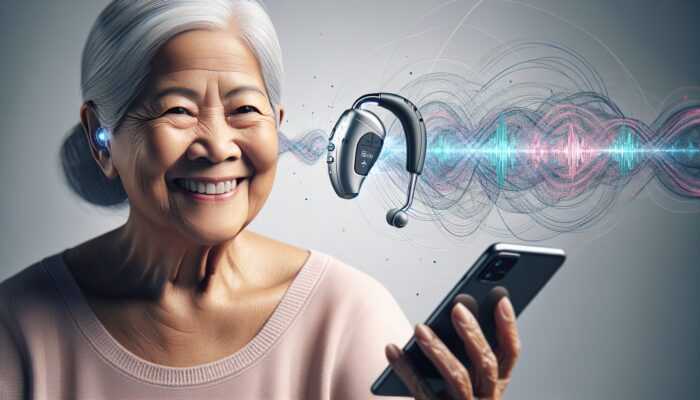Global Movement to Enhance Awareness of Ear Health
The increasing emphasis on ear health signifies a considerable global shift towards prioritising comprehensive wellness. This rising consciousness is not just a transient trend; it embodies a profound transformation in how societies understand and care for auditory well-being. Central to this movement are educational initiatives, groundbreaking technological advancements, and a growing interest in holistic health practices. As more individuals acknowledge the importance of preserving their hearing abilities, the landscape of ear health is undergoing significant changes, underscoring the necessity for proactive measures and informed choices to protect auditory function effectively.
Empowering Communities Through Comprehensive Education on Ear Care

Educational campaigns have emerged as a crucial force in disseminating knowledge about effective ear health practices. Organisations worldwide are dedicating resources to programmes aimed at informing individuals about essential ear care techniques. This encompasses vital information on avoiding excessive noise exposure, the importance of regular check-ups, and how to recognise early signs of hearing loss. For example, initiatives led by the World Health Organization (WHO) strive to educate communities about the risks associated with noise-induced hearing loss, emphasising that proactive measures can significantly reduce the likelihood of auditory damage. By equipping the public with knowledge, these campaigns foster a culture of awareness and care.
Community workshops and online seminars are gaining popularity, providing accessible platforms for expert discussions on ear health. These interactive sessions help demystify common misconceptions, allowing participants to engage directly with audiologists and hearing specialists. Consequently, individuals become more informed about the necessity of regular hearing assessments, the impact of lifestyle choices on ear health, and the importance of protective measures in their daily routines. This enhanced understanding empowers people to actively take charge of their auditory well-being and encourages them to advocate for healthy practices within their communities.
Furthermore, educational institutions are increasingly integrating ear health awareness into their curriculums. Schools across the globe are teaching students about the importance of ear safety, fostering a culture of care from an early age. This early exposure to ear health not only empowers future generations to prioritise their auditory well-being but also inspires them to champion healthy practices within their communities. By instilling this knowledge in children, we cultivate a society that values and protects hearing health for years to come.
Transforming Audiology Through Technological Innovations
The field of audiology is undergoing a remarkable transformation, driven by cutting-edge technological innovations. Recent advancements in hearing aids and auditory devices have made monitoring ear health more accessible than ever. Today’s hearing aids boast impressive features such as Bluetooth connectivity, noise cancellation, and adjustable settings, significantly enhancing user experience. These innovations empower individuals with hearing loss to engage more fully in their environments, fostering a more inclusive society where auditory challenges are effectively addressed.
Tele-audiology has emerged as a groundbreaking service, allowing patients to receive consultations and follow-up care remotely. This service is particularly advantageous for individuals living in remote or underserved areas, where access to audiology clinics may be limited. Through telemedicine, patients can conveniently have their hearing tested and discussed without the necessity of travel, effectively breaking down barriers to care and ensuring that everyone has access to the essential support for their auditory health.
Mobile applications dedicated to monitoring ear health are also playing a vital role in promoting proactive care. These user-friendly applications enable individuals to track changes in their hearing over time, set reminders for check-ups, and access educational resources directly from their devices. Such technological innovations foster a proactive approach to ear health, emphasising the importance of regular monitoring and early intervention to maintain optimal auditory function.
Growing Public Interest in Holistic Wellness and Its Influence on Ear Health
A significant cultural shift towards holistic wellness is reshaping how individuals view ear health. As people increasingly recognise the interconnection between physical, mental, and auditory health, they are more inclined to prioritise their ear well-being alongside other health aspects. This burgeoning public interest is evident in the skyrocketing popularity of wellness blogs, podcasts, and social media channels that focus on holistic health and wellness topics.
Health influencers and audiology experts are harnessing these platforms to share valuable insights about ear care, debunk prevalent myths, and promote healthy auditory practices. The dialogue surrounding ear health has become more inclusive, encouraging discussions about the psychological impacts of hearing loss and the significance of mental well-being concerning auditory health. This broader perspective is instrumental in destigmatising hearing loss and cultivating a culture of acceptance and understanding among the public.
As awareness grows, so does the demand for products and services that support ear health. From dietary supplements aimed at enhancing auditory function to ergonomic headphones designed to minimise strain, consumers are actively seeking innovative solutions that align with their wellness goals. This shift in consumer behaviour is prompting companies to invest in research and development, leading to a vibrant market focused on maintaining and improving ear health while catering to the needs of a more health-conscious public.
The Impact of Modern Lifestyles on Ear Health

Modern lifestyles are increasingly affecting ear health, influenced by urbanisation, technological advancements, and evolving leisure activities. This contemporary reality presents unique challenges that necessitate heightened awareness and proactive measures to safeguard auditory well-being. As individuals adapt to these changes, understanding the implications of lifestyle choices on ear health becomes crucial for preventing long-term auditory damage.
The Dangers of Noise Pollution on Hearing Health
The relentless noise characteristic of urban environments poses a significant threat to ear health. Cities worldwide are grappling with escalating levels of noise pollution, which have been linked to an increase in hearing damage and related health issues. Prolonged exposure to noise exceeding 85 decibels can lead to irreversible hearing loss, a reality many individuals remain unaware of until it is too late. This critical issue highlights the urgent need for public awareness campaigns aimed at educating individuals about the risks associated with noise exposure in their daily lives.
Numerous studies underscore the correlation between heightened noise levels in urban settings and the prevalence of hearing impairments. For instance, research conducted by the European Institute for Gender Equality indicates that residents in metropolitan areas experience a higher incidence of hearing loss compared to those in quieter regions. This data emphasises the necessity of raising public awareness about the risks associated with noise exposure and the importance of adopting protective measures to mitigate its impact.
Addressing noise pollution requires collective action from various stakeholders. Urban planners and policymakers increasingly advocate for noise-reducing policies, such as creating green spaces that help absorb sound. Meanwhile, individuals can take personal responsibility by adopting habits that minimise noise exposure, such as utilising noise-cancelling headphones in busy environments and advocating for quieter public spaces. By working together, we can create healthier environments that protect our auditory health.
The Influence of Personal Audio Devices on Hearing Health
The widespread use of personal audio devices has revolutionised how people consume entertainment and communicate, yet this convenience comes at a potential cost to ear health. The popularity of headphones and earbuds has led many individuals to listen at high volumes, often oblivious to the potential risks posed to their ear health. Listening to music at excessive volumes for prolonged periods can significantly heighten the risk of noise-induced hearing loss, a concern that warrants immediate attention and education.
Experts recommend adhering to the 60/60 rule: listening at no more than 60% of maximum volume for no longer than 60 minutes at a time. By following this guideline, individuals can enjoy their favourite audio content while taking steps to protect their ears from potential damage. Furthermore, the emergence of awareness campaigns aimed at promoting responsible listening habits is crucial in countering the potential dangers associated with personal audio devices, helping users make informed choices about their auditory health.
Manufacturers are also responding to this need by creating safer audio products. Many brands now offer headphones equipped with built-in volume limiters to help users maintain safe listening levels. This innovation reflects a growing commitment to ear health and underscores the importance of consumers choosing products that prioritise auditory safety, ultimately contributing to a culture of responsible listening.
Workplace and Recreational Hazards Affecting Ear Health

Certain workplaces and recreational activities expose individuals to conditions that can adversely affect ear health. Industries such as construction, manufacturing, and entertainment often require employees to work in environments with high noise levels. Without adequate ear protection, these workers face an elevated risk of developing hearing loss over time, making it essential for employers to prioritise auditory safety in the workplace.
Employers must acknowledge their responsibility in safeguarding the auditory health of their employees. Implementing comprehensive hearing conservation programmes that include regular auditory assessments, training on noise exposure, and providing protective equipment is vital to ensuring a safe work environment. Moreover, workers should be encouraged to advocate for their ear health, understanding that they have the right to work in a safe environment where their auditory well-being is prioritised.
Recreational activities, such as attending concerts or sporting events, also pose significant risks to ear health. The intense noise levels associated with live performances can result in temporary or even permanent hearing damage. Awareness campaigns that educate attendees about the importance of ear protection during high-volume events are essential in promoting a culture of safety and responsibility in leisure activities, ensuring that individuals can enjoy their experiences without compromising their hearing.
The Crucial Importance of Preventive Measures in Ear Health
As awareness of ear health expands, so does the focus on preventive measures. Just as individuals prioritise heart health or physical fitness, adopting a proactive approach to ear health can yield significant long-term benefits. By prioritising prevention, individuals can take meaningful steps to safeguard their auditory well-being and enhance their quality of life.
The Importance of Routine Hearing Check-ups for Proactive Care
Regular hearing examinations are fundamental to preventive ear health. Routine assessments facilitate the early detection of hearing issues, allowing for timely intervention that can prevent further deterioration. The significance of annual hearing tests cannot be overstated, particularly for individuals at higher risk, such as those with a family history of hearing loss or those frequently exposed to high noise levels. By prioritising regular check-ups, individuals can stay informed about their auditory health and take appropriate measures to address any concerns.
Many countries are now advocating for regular screenings, akin to vision checks, emphasising the necessity of routine auditory assessments within public health initiatives. The benefits of early detection extend beyond physical health; individuals are better equipped to navigate social situations, maintain relationships, and enjoy an improved quality of life when they address hearing issues promptly. This proactive approach reinforces the importance of prioritising ear health as an integral aspect of overall well-being.
Moreover, telehealth services are making it easier than ever for individuals to access hearing check-ups. Patients can now consult with audiologists remotely, eliminating barriers to care that may exist due to geographical distance or mobility issues. This accessibility is especially crucial for individuals living in remote areas or those with limited access to specialised services, ensuring that everyone has the opportunity to prioritise their ear health and receive the necessary support.
The Essential Role of Protective Earwear in Safeguarding Hearing
The use of protective earwear is paramount in environments where noise exposure poses a significant threat. Earplugs and earmuffs are effective tools that can substantially reduce noise levels, protecting hearing during concerts, construction work, and other loud activities. Awareness campaigns that focus on the importance of protective gear are crucial in cultivating a culture of safety and responsibility concerning ear health.
Individuals must be educated about the various types of ear protection available, including custom-fitted options that offer a more comfortable and secure fit. Audiologists can provide guidance on suitable protective gear tailored to individual needs, ensuring maximum efficacy in safeguarding ear health. By understanding the importance of using protective earwear, individuals can take proactive steps to preserve their hearing.
Additionally, the integration of technology into protective earwear represents an exciting development in ear health. Smart earplugs equipped with noise-cancellation features allow wearers to enjoy their surroundings while minimising harmful sounds. This innovative approach not only enhances safety but also encourages more individuals to adopt protective measures in their daily lives, ultimately fostering a culture of awareness and responsibility regarding ear health.
Making Lifestyle Adjustments to Enhance Ear Health
Simple lifestyle adjustments can profoundly impact ear health. Individuals can incorporate habits that support auditory well-being into their daily routines, significantly enhancing their overall quality of life. For instance, managing stress through mindfulness and relaxation techniques has been shown to benefit both mental and auditory health, underscoring the importance of holistic well-being.
Nutrition also plays a critical role in maintaining ear health. A balanced diet rich in essential nutrients, such as vitamins A, C, E, and omega-3 fatty acids, supports optimal auditory function. Additionally, avoiding excessive alcohol and tobacco use can significantly reduce the risk of hearing loss. By prioritising a nutrient-rich diet, individuals can promote their ear health and enhance their overall wellness.
Regular physical activity not only benefits cardiovascular health but also improves blood flow to the ears, supporting optimal auditory function. Individuals should strive to incorporate exercise into their daily routines, fostering a holistic approach to their physical and auditory well-being. By making these lifestyle adjustments, individuals can take proactive steps to protect their ear health and enjoy a better quality of life.
Revolutionary Technological Innovations in Ear Care
The evolution of technology is paving the way for groundbreaking advancements in ear care, creating new opportunities for individuals to manage and enhance their auditory health. As innovation continues to propel the field of audiology forward, individuals can benefit from more effective solutions to address their hearing needs and promote overall ear health.
Modern Hearing Aids: A Significant Advancement in Audiology Technology
Modern hearing aids represent a substantial leap forward in auditory technology. Today’s devices are smaller, smarter, and more efficient than ever, offering features that enhance sound quality while promoting user comfort. Many hearing aids now come equipped with Bluetooth connectivity, allowing users to stream audio directly from their smartphones or other devices, facilitating a seamless listening experience that enriches daily life.
The customisation options available in contemporary hearing aids are particularly noteworthy. Users can fine-tune settings to match their unique hearing profiles, ensuring optimal sound quality tailored to their specific environments. This level of personalisation empowers individuals to engage fully in social interactions, reducing the stigma often associated with hearing loss and fostering a sense of belonging.
Furthermore, advancements in artificial intelligence are revolutionising hearing aid functionality. AI-driven models can adapt to varying environments, automatically adjusting settings based on background noise levels and the user’s preferences. This innovation is transforming the user experience, making auditory devices more intuitive and user-friendly while enhancing overall satisfaction and effectiveness.
Transforming Ear Health with Monitoring Apps
The rise of mobile technology has ushered in a new era of ear health monitoring apps, empowering individuals to take charge of their auditory well-being. These applications provide users with tools to track their hearing changes, set reminders for check-ups, and access personalised care recommendations directly from their devices.
Many of these apps also include features that educate users about ear health, offering tips for safe listening practices and information on the effects of noise exposure. By putting valuable resources in the hands of consumers, these apps promote a proactive approach to ear health, encouraging individuals to engage in self-care and prioritise their auditory well-being.
Emerging partnerships between app developers and audiology professionals are further enhancing the effectiveness of these tools. Collaborative efforts aim to ensure that the information provided is accurate and relevant, creating a valuable resource for those looking to actively monitor their hearing health and make informed decisions about their care.
Telemedicine: Revolutionising Audiology Services
Telemedicine is transforming the field of audiology, making ear health services more accessible and convenient for individuals worldwide. Remote consultations allow patients to connect with audiologists from the comfort of their homes, breaking down geographical barriers to care and ensuring that everyone has access to the necessary support for their auditory health.
This innovative approach is particularly valuable for individuals living in rural areas, where access to specialised audiology services may be limited. Teleconsultations also promote continuity of care, enabling patients to receive follow-up assessments without the need for extensive travel, thus enhancing their overall experience and satisfaction with auditory healthcare.
Patients can now receive tailored recommendations based on their unique auditory needs, ensuring that they receive the support necessary for maintaining optimal ear health. As telemedicine continues to evolve, it is poised to become an integral part of the healthcare landscape, transforming how individuals manage their auditory well-being and enhancing access to essential services.
Innovative Ear Protection Devices: A New Frontier
The development of innovative ear protection devices has emerged as a critical focus within the realm of ear health. New technologies in earplugs and earmuffs are designed for enhanced comfort and protection against noise-induced hearing loss. From musicians to industrial workers, these products cater to diverse needs, ensuring that protection is accessible to all individuals who require it.
Custom-fitted earplugs, for example, offer a snug fit that enhances noise reduction, making them ideal for individuals exposed to loud environments for prolonged periods. Additionally, advancements in materials have led to the creation of lightweight and durable options that prioritise user comfort, encouraging more people to adopt protective measures in their daily lives.
Moreover, smart ear protection devices are gaining traction in the market. These gadgets can adjust their noise-cancellation features based on the surrounding environment, providing users with a versatile solution for various situations. This innovative technology encourages more individuals to adopt protective measures and fosters a culture of awareness and safety regarding ear health.
The Impact of Nutrition on Ear Health
Nutrition is a fundamental aspect of overall health, and its role in supporting ear health is becoming increasingly recognised. A well-balanced diet rich in specific nutrients can significantly contribute to maintaining auditory function and preventing hearing loss. By understanding the connection between nutrition and ear health, individuals can make informed dietary choices that benefit their auditory well-being.
Key Nutrients to Support Optimal Ear Function
Certain vitamins and minerals are essential for maintaining healthy ears. Nutrients such as magnesium, zinc, and vitamins A, C, and E play vital roles in ensuring optimal auditory function. Magnesium, in particular, has been shown to protect against noise-induced hearing loss by supporting blood flow to the inner ear, highlighting the importance of nutrient-rich diets for auditory health.
Individuals should aim to incorporate foods rich in these essential nutrients into their diets. Leafy greens, nuts, seeds, and fruits are excellent sources of these vitamins and minerals. By prioritising nutritional intake, individuals can bolster their ear health and reduce the risk of developing hearing impairments later in life. Making conscious dietary choices can serve as a powerful tool in promoting overall well-being.
Moreover, ongoing research continues to explore the relationship between diet and auditory health. Studies have demonstrated that diets high in antioxidants may help combat oxidative stress in the auditory system, further emphasising the importance of proper nutrition in supporting ear health and preventing hearing loss.
Dietary Patterns that Promote Better Auditory Health
Specific dietary patterns can promote better ear health and prevent hearing loss. The Mediterranean diet, characterised by its emphasis on fruits, vegetables, whole grains, and healthy fats, is often cited as beneficial for overall health, including auditory function. This diet is rich in omega-3 fatty acids and antioxidants, both of which contribute to maintaining healthy hearing and reducing the risk of auditory impairments.
Additionally, the DASH (Dietary Approaches to Stop Hypertension) diet has shown promise in supporting ear health due to its focus on reducing hypertension—a common risk factor for hearing loss. By adhering to these dietary patterns, individuals can not only improve their overall health but also prioritise their auditory well-being. Staying informed about dietary trends and research can empower individuals to make choices that support their ear health proactively.
As more research emerges, the link between diet and ear health continues to evolve. Individuals are encouraged to stay informed about emerging studies and adapt their eating habits to support their ear health proactively, recognising that nutrition plays an integral role in auditory well-being.
The Role of Supplements in Enhancing Ear Health
Certain supplements may aid in protecting and enhancing ear function. Nutritional supplements containing essential vitamins and minerals can be beneficial for individuals at risk of hearing loss. For instance, research has indicated that ginkgo biloba may improve circulation to the inner ear, promoting better auditory function and supporting overall ear health.
Before starting any supplementation regimen, individuals should consult with healthcare professionals to ensure safety and efficacy. Personalised recommendations based on individual health needs can help optimise the benefits of supplements for ear health. This tailored approach ensures that individuals can make informed decisions about their dietary supplements and their impact on auditory well-being.
Additionally, awareness campaigns promoting the use of specific supplements for ear health are gaining traction. These initiatives aim to educate the public on the potential benefits of incorporating certain supplements into their daily routines, ultimately empowering individuals to take charge of their auditory well-being and prioritise their ear health proactively.
The Importance of Hydration in Supporting Ear Health
Adequate hydration is essential for maintaining the fluid balance in the inner ear, which supports optimal hearing function. Dehydration can lead to issues such as tinnitus and an increased risk of hearing loss. It is crucial for individuals to prioritise hydration, especially during hot weather or physical activity, to safeguard their ear health.
Maintaining proper hydration also supports overall health, enhancing cognitive function and physical performance. By drinking enough water and incorporating water-rich foods into their diets, individuals can simultaneously promote their ear health and overall well-being. Making hydration a priority can have far-reaching benefits for both auditory function and overall health.
Additionally, organisations are increasingly emphasising the importance of hydration in maintaining ear health. Educational campaigns highlight the link between hydration and auditory function, encouraging individuals to adopt healthy hydration habits as part of their daily routines. By understanding this connection, individuals can take proactive steps to protect their ear health and improve their quality of life.
The Intriguing Connection Between Ear Health and Mental Well-being
The connection between ear health and mental well-being is a growing area of interest in current research. As awareness of this relationship expands, more individuals are recognising the importance of maintaining auditory health as a key component of overall mental wellness. Understanding the interplay between hearing health and psychological well-being is essential for fostering a holistic approach to health.
The Impact of Hearing Loss on Mental Health and Social Interaction
Hearing impairment can have profound effects on mental health, often leading to social isolation and emotional distress. Individuals with hearing loss may struggle to communicate effectively, resulting in feelings of frustration and loneliness. This isolation can exacerbate mental health issues such as anxiety and depression, highlighting the need for comprehensive support for those experiencing hearing challenges.
Research has shown that individuals with untreated hearing loss are at a higher risk of developing cognitive decline and mental health disorders. Studies conducted by institutions like Johns Hopkins University reveal a strong correlation between hearing loss and an increased risk of dementia, emphasising the importance of addressing auditory health proactively to mitigate these risks.
Recognising the mental health implications of hearing loss is crucial for both individuals and healthcare providers. Creating a supportive environment that encourages open communication about auditory issues can foster a greater understanding of the challenges faced by those with hearing impairments, ultimately promoting empathy and effective support systems.
Psychological Benefits of Maintaining Good Ear Health
Maintaining good ear health can yield significant psychological benefits, enhancing overall well-being and quality of life. Individuals who prioritise their auditory health often experience improved social engagement, which can bolster self-esteem and reduce feelings of isolation. By actively addressing their hearing health, individuals can foster meaningful connections with others, promoting a sense of belonging and community.
Research suggests that individuals with normal hearing levels are more likely to participate in social activities and engage in meaningful conversations. This engagement is vital for maintaining strong relationships, fostering a sense of belonging, and enhancing mental well-being. By prioritising ear health, individuals can improve their overall quality of life and cultivate a positive social network.
Additionally, the act of addressing hearing issues—whether through the use of hearing aids, regular check-ups, or protective measures—can enhance an individual’s sense of agency. Taking proactive steps to maintain ear health empowers individuals to take control of their well-being, contributing to improved mental health outcomes and a greater sense of fulfilment in life.
Effective Strategies to Support Mental Health Through Ear Care
Addressing ear health can be an integral part of a broader approach to mental well-being. Strategies that promote auditory health can significantly contribute to overall mental wellness. For instance, regular hearing assessments, combined with the use of hearing aids or assistive listening devices, can facilitate greater social interaction and reduce feelings of isolation. This proactive approach can enhance emotional resilience and foster a positive outlook on life.
Incorporating mindfulness practices into daily routines can also be beneficial for mental well-being. Mindfulness techniques, such as meditation and deep breathing exercises, can help manage stress and anxiety, ultimately supporting both auditory and mental health. By integrating these practices into their lives, individuals can cultivate a greater sense of balance and well-being.
Furthermore, support groups for individuals with hearing loss can provide a safe space for sharing experiences and coping strategies. These communities foster connections, allowing individuals to feel understood and supported in their journey toward better ear health and mental well-being. By engaging with others who share similar experiences, individuals can build resilience and enhance their overall quality of life.
The Role of Hearing Aids in Enhancing Mental Well-being
Hearing aids play a vital role in improving the mental health challenges associated with hearing loss. By enhancing communication abilities, these devices help individuals engage more fully in social interactions, reducing feelings of isolation and loneliness. The ability to participate in conversations and activities without frustration can significantly enhance personal relationships, leading to improved emotional well-being.
Research indicates that individuals who use hearing aids report higher levels of life satisfaction and overall happiness. The capacity to communicate effectively and engage in social settings fosters a sense of connection and belonging, which are essential for mental health. This positive impact underscores the importance of addressing hearing loss as part of a holistic approach to well-being.
Moreover, advancements in hearing aid technology—such as connectivity features and customisable settings—allow users to tailor their devices to their preferences, further enhancing their effectiveness. This personalisation fosters a sense of control and empowerment, contributing positively to mental health and overall quality of life. As awareness of the link between ear health and mental well-being grows, prioritising auditory health becomes increasingly vital for enhancing overall life satisfaction.
Looking Ahead: Anticipated Trends in Ear Health
The future of ear health is poised for exciting developments as ongoing research and technological advancements continue to shape the landscape of audiology. As awareness grows, a focus on preventive care and innovative solutions will become increasingly central to maintaining auditory well-being. By embracing these trends, individuals can take proactive steps toward securing their ear health for years to come.
Emerging Research in Audiology: New Insights and Innovations
Ongoing studies in audiology are uncovering new ways to improve ear health and hearing. Researchers are exploring various aspects of auditory function, from the biological mechanisms behind hearing loss to the impacts of lifestyle choices on ear health. This research is critical for developing new treatment options and preventive measures that can help individuals maintain optimal auditory function.
For example, advancements in gene therapy are being investigated as potential solutions for specific types of hearing loss. Early findings suggest that genetic interventions may one day provide a means of restoring hearing function, representing a significant breakthrough in the field of audiology. As research continues to evolve, it will pave the way for innovative treatments that can enhance ear health and improve the quality of life for individuals with hearing impairments.
Additionally, studies focusing on the relationship between diet and auditory health are gaining momentum. Research is delving into how specific nutrients can influence hearing preservation and overall auditory function, paving the way for dietary guidelines tailored to ear health. As these studies evolve, they will empower individuals to take informed actions regarding their auditory well-being, emphasising the importance of preventive measures and early interventions for maintaining hearing health.
Predicted Technological Advancements: The Future of Ear Care
Future technologies are anticipated to revolutionise ear care and treatment further. Innovations such as artificial intelligence, machine learning, and advanced materials will continue to enhance the functionality and comfort of hearing aids and protective devices. These advancements will not only improve user experience but also broaden accessibility to effective ear health solutions.
For instance, the integration of AI into hearing aids is expected to enhance sound processing capabilities, allowing devices to better adapt to various environments and user preferences. This advancement will significantly improve user experience, making auditory aids even more effective for diverse listening situations. As technology continues to evolve, individuals can look forward to even more intuitive and user-friendly solutions for managing their hearing health.
Additionally, wearable technology may become increasingly prevalent in ear health monitoring. Devices capable of tracking auditory health metrics in real time will empower individuals to stay informed about their ear health, facilitating timely interventions when needed. As these advancements unfold, they will reshape the landscape of ear care, making it more accessible and effective for individuals worldwide.
Shifts in Public Health Priorities: Emphasising Prevention
There is a growing emphasis on preventive care and early intervention in ear health. Public health initiatives are increasingly recognising the importance of addressing hearing loss proactively, rather than relying solely on reactive measures. This shift in priorities is evident in the promotion of regular hearing screenings and educational campaigns aimed at raising awareness about ear health.
Moreover, governments and health organisations are beginning to invest in resources and programmes that support auditory health, recognising its significance in overall well-being. As public health policies evolve, individuals will benefit from increased access to preventive services, ensuring that ear health is prioritised alongside other aspects of healthcare. This collective commitment to protective measures will foster a healthier, more informed population dedicated to maintaining optimal auditory function.
This emphasis on preventive care is not just a trend; it represents a fundamental shift in how societies prioritise health and well-being. As awareness grows, the collective commitment to safeguarding ear health will likely lead to a healthier, more informed global population that values auditory well-being as a key aspect of overall health.
Frequently Asked Questions Regarding Ear Health
Why is it crucial to maintain good ear health?
Maintaining good ear health is essential because it directly impacts communication, social interactions, and overall quality of life. Prioritising ear health can help prevent hearing loss and its associated mental health challenges, promoting a healthier and more fulfilling life.
What are common indicators of hearing loss?
Common signs of hearing loss include difficulty understanding conversations, frequently asking others to repeat themselves, and experiencing ringing in the ears (tinnitus). Recognising these symptoms early can facilitate timely intervention and care.
How can I protect my ears from noise-induced damage?
To protect your ears from damage, wear ear protection in loud environments, adhere to the 60/60 rule when using headphones, and limit exposure to loud noises whenever possible. Taking these precautions can help preserve your hearing.
How often should I have my hearing checked?
It is recommended to have a hearing check-up at least once a year, especially for individuals over 50 or those at higher risk of hearing loss due to occupational or environmental factors. Regular assessments can help identify issues before they worsen.
Can diet impact my ear health?
Yes, a healthy diet rich in vitamins and minerals can significantly support ear health. Nutrients like magnesium, zinc, and omega-3 fatty acids are particularly beneficial for maintaining optimal auditory function and preventing hearing impairments.
Are hearing aids effective for everyone with hearing loss?
Hearing aids are effective for many individuals with hearing loss, but their efficacy can vary based on the type and severity of hearing impairment. Consulting an audiologist is crucial for personalised recommendations tailored to individual needs.
How can I maintain good ear hygiene?
Maintain good ear hygiene by gently cleaning the outer ear with a damp cloth, avoiding inserting objects into the ear canal, and seeking professional assistance for earwax removal if necessary. Proper hygiene is essential for preventing infections and ensuring optimal ear health.
What role does telemedicine play in ear health?
Telemedicine offers convenient access to audiology services, allowing patients to consult with professionals remotely. This approach enhances accessibility and continuity of care for ear health management, making it easier for individuals to prioritise their auditory well-being.
How can I manage tinnitus effectively?
Managing tinnitus involves identifying triggers, practising relaxation techniques, and using sound therapy or hearing aids to mask the noise. Consulting a healthcare professional is recommended for personalised strategies to address this common auditory challenge.
What innovations are shaping the future of ear health?
Innovations such as advanced hearing aids, telemedicine, and ear health monitoring apps are shaping the future of ear health, making care more accessible and personalised for individuals worldwide. These advancements promise to enhance the overall experience of managing auditory health.
Explore more with us on X!
The post Ear Health: The Emerging Trend Everyone Should Embrace appeared first on The Microsuction Ear Wax Removal Network.





























